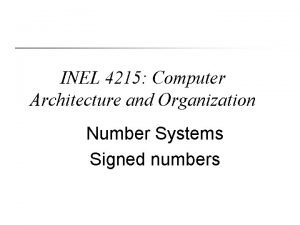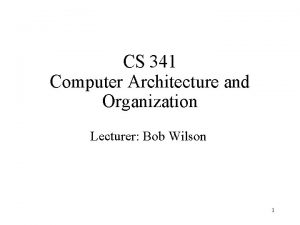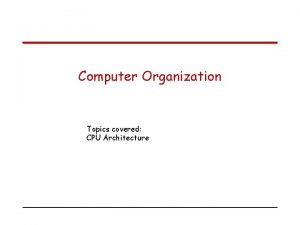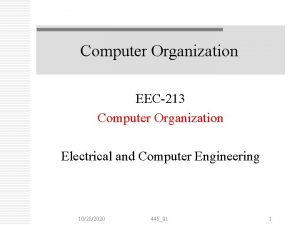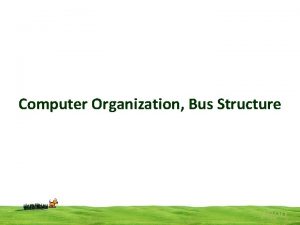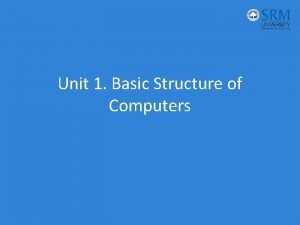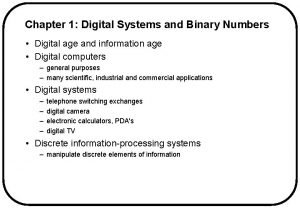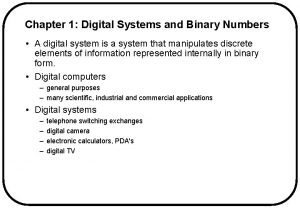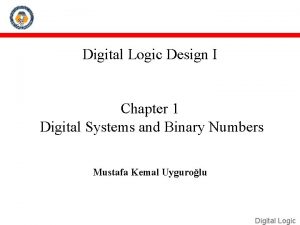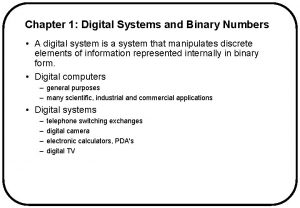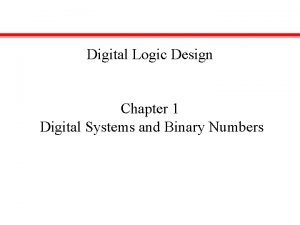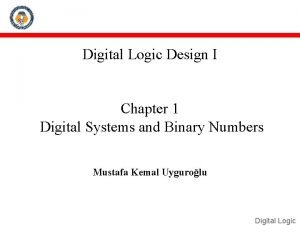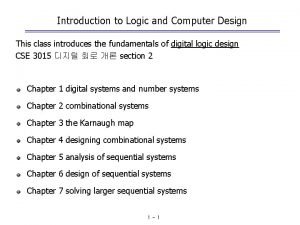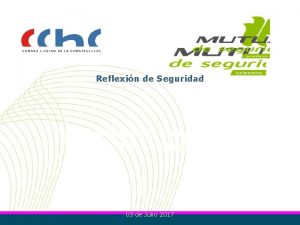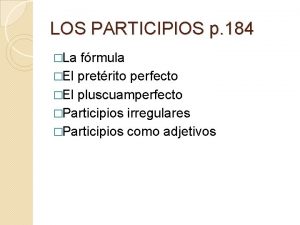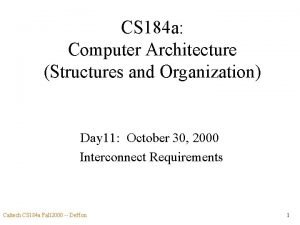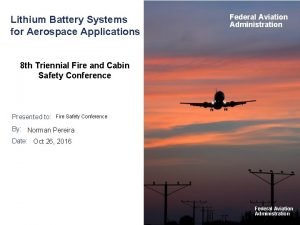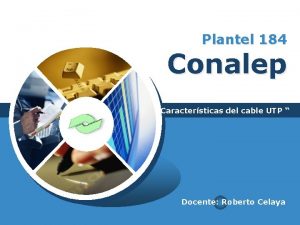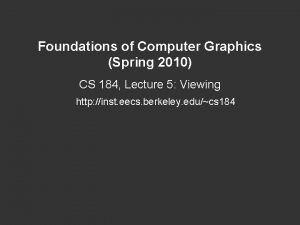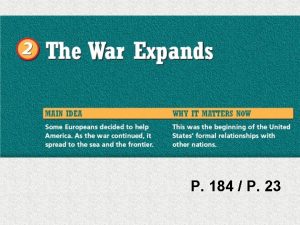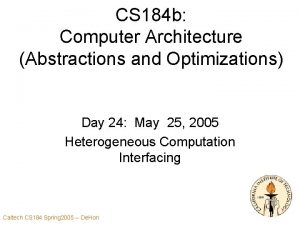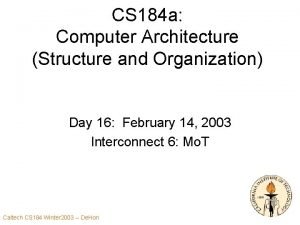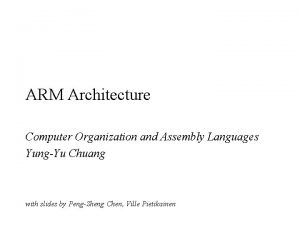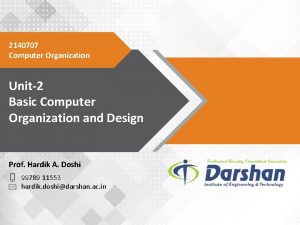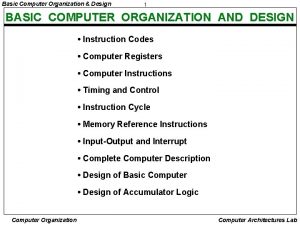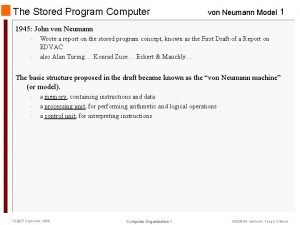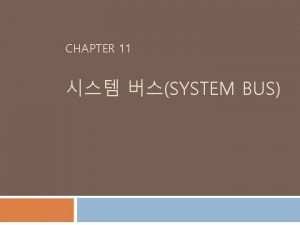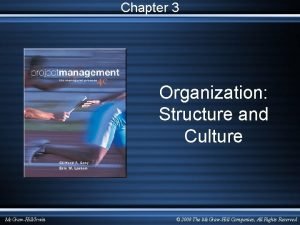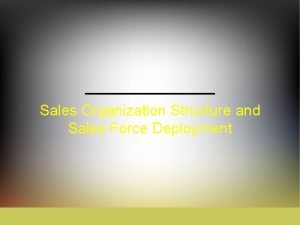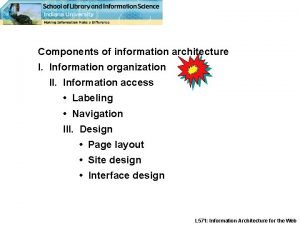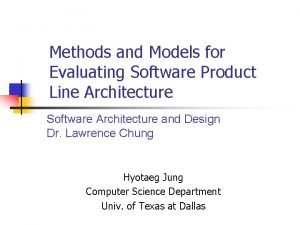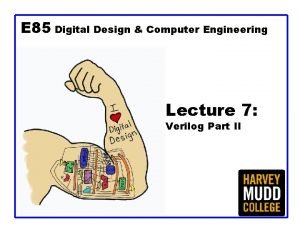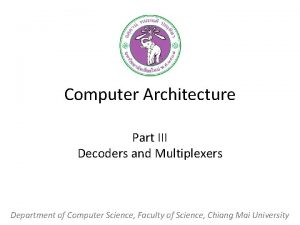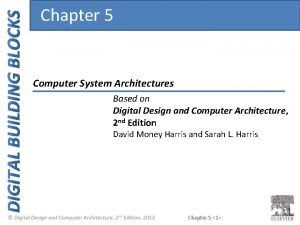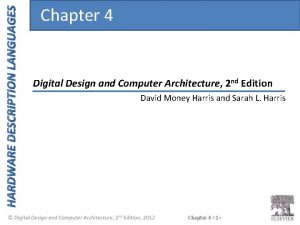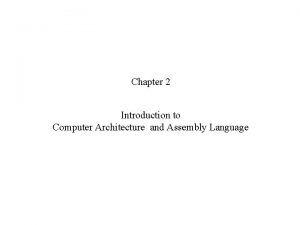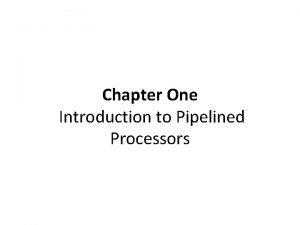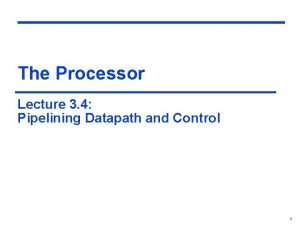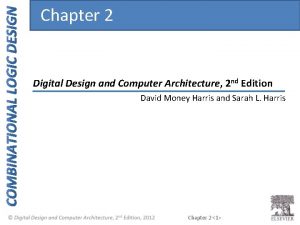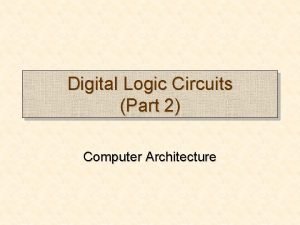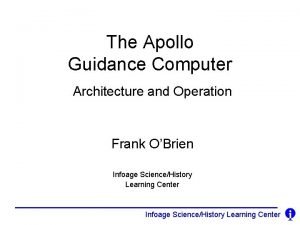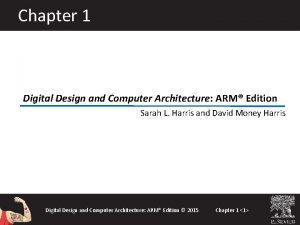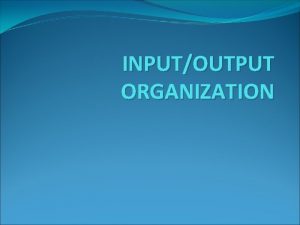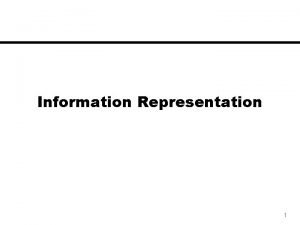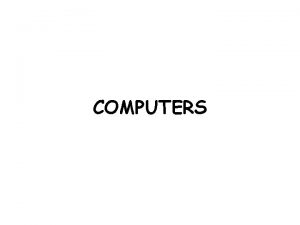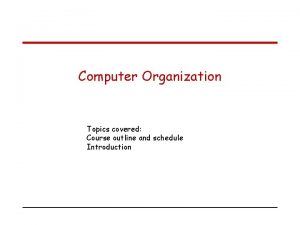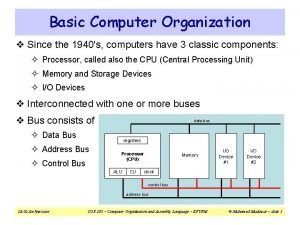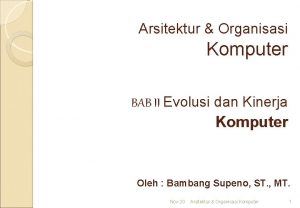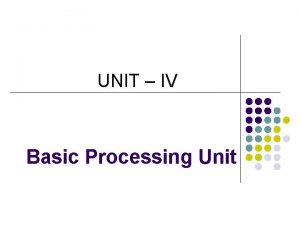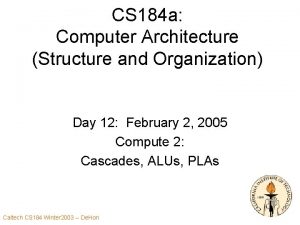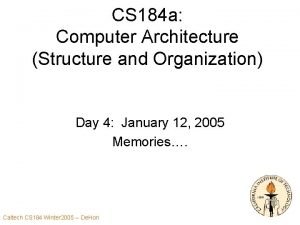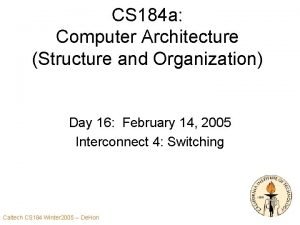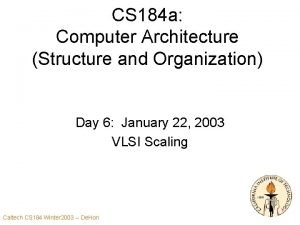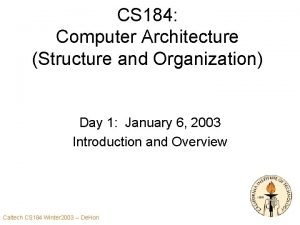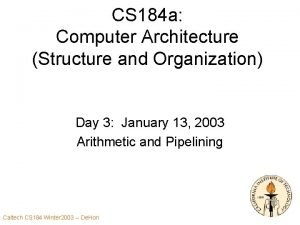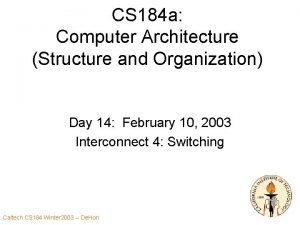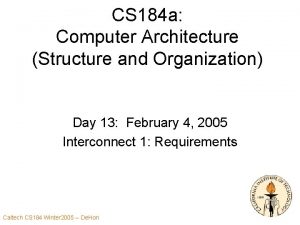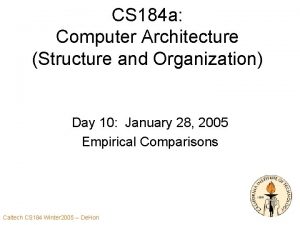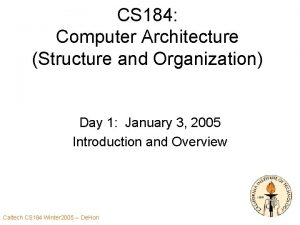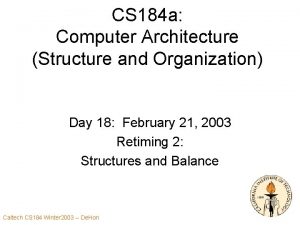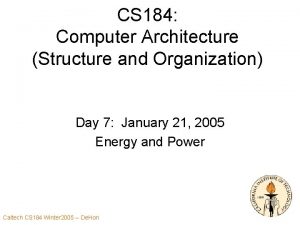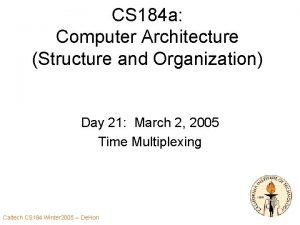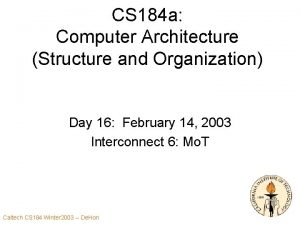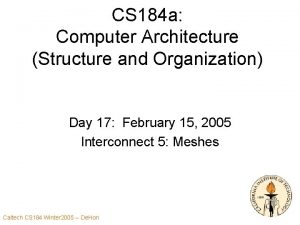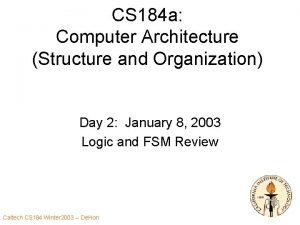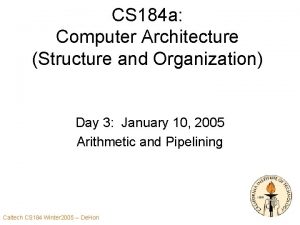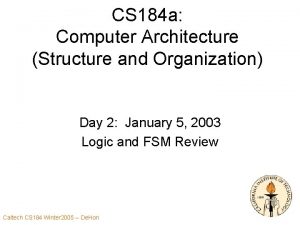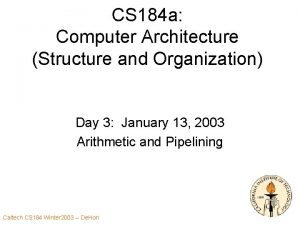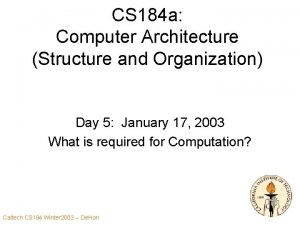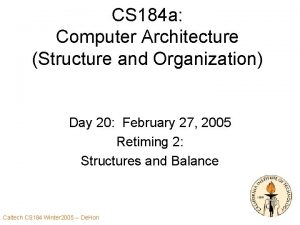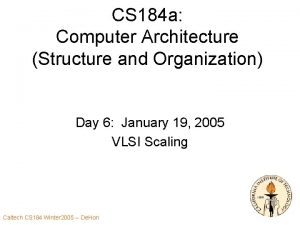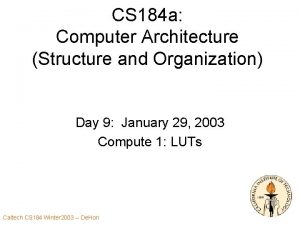CS 184 a Computer Architecture Structure and Organization


























































![Example: Contrast • Vsum 4(a, b, c) • Vsum(a, b) – c[0]=a[0]+b[0]; – c Example: Contrast • Vsum 4(a, b, c) • Vsum(a, b) – c[0]=a[0]+b[0]; – c](https://slidetodoc.com/presentation_image_h/7cc0c114addd711900c57653bc82b37a/image-59.jpg)
![Computation: vsum 4 • Vsum 4(a, b, c) – c[0]=a[0]+b[0]; – c[1]=a[1]+b[1]; – c[2]=a[2]+b[2]; Computation: vsum 4 • Vsum 4(a, b, c) – c[0]=a[0]+b[0]; – c[1]=a[1]+b[1]; – c[2]=a[2]+b[2];](https://slidetodoc.com/presentation_image_h/7cc0c114addd711900c57653bc82b37a/image-60.jpg)
![Computation: vsum • Vsum(a, b) – c = new int[a. length()]; – for(I=0; I<a. Computation: vsum • Vsum(a, b) – c = new int[a. length()]; – for(I=0; I<a.](https://slidetodoc.com/presentation_image_h/7cc0c114addd711900c57653bc82b37a/image-61.jpg)
![Compute Vsum 4 on datapath • Vsum 4(a, b, c) – c[0]=a[0]+b[0]; – c[1]=a[1]+b[1]; Compute Vsum 4 on datapath • Vsum 4(a, b, c) – c[0]=a[0]+b[0]; – c[1]=a[1]+b[1];](https://slidetodoc.com/presentation_image_h/7cc0c114addd711900c57653bc82b37a/image-62.jpg)
![Compute Vsum 4 • Vsum 4(a, b, c) – c[0]=a[0]+b[0]; – c[1]=a[1]+b[1]; – c[2]=a[2]+b[2]; Compute Vsum 4 • Vsum 4(a, b, c) – c[0]=a[0]+b[0]; – c[1]=a[1]+b[1]; – c[2]=a[2]+b[2];](https://slidetodoc.com/presentation_image_h/7cc0c114addd711900c57653bc82b37a/image-63.jpg)
![Compute Vsum • Vsum(a, b) – c = new int[a. length()]; – for(I=0; I<a. Compute Vsum • Vsum(a, b) – c = new int[a. length()]; – for(I=0; I<a.](https://slidetodoc.com/presentation_image_h/7cc0c114addd711900c57653bc82b37a/image-64.jpg)
![Compute Vsum • Vsum(a, b) – c = new int[a. length()]; – for(I=0; I<a. Compute Vsum • Vsum(a, b) – c = new int[a. length()]; – for(I=0; I<a.](https://slidetodoc.com/presentation_image_h/7cc0c114addd711900c57653bc82b37a/image-65.jpg)



![New Ops • Important new operations: – DST B[Asrc] Instr: ALUOP Bsel Write Bsrc New Ops • Important new operations: – DST B[Asrc] Instr: ALUOP Bsel Write Bsrc](https://slidetodoc.com/presentation_image_h/7cc0c114addd711900c57653bc82b37a/image-69.jpg)
![Compute Vsum • Vsum(a, b) – c = new int[a. length()]; – for(I=0; I<a. Compute Vsum • Vsum(a, b) – c = new int[a. length()]; – for(I=0; I<a.](https://slidetodoc.com/presentation_image_h/7cc0c114addd711900c57653bc82b37a/image-70.jpg)
![Compute Vsum • Vsum(a, b) – c = new int[a. length()]; – for(I=0; I<a. Compute Vsum • Vsum(a, b) – c = new int[a. length()]; – for(I=0; I<a.](https://slidetodoc.com/presentation_image_h/7cc0c114addd711900c57653bc82b37a/image-71.jpg)
![Compute Vsum • Vsum(a, b) – c = new int[a. length()]; – for(I=0; I<a. Compute Vsum • Vsum(a, b) – c = new int[a. length()]; – for(I=0; I<a.](https://slidetodoc.com/presentation_image_h/7cc0c114addd711900c57653bc82b37a/image-72.jpg)
![Compute Vsum • Vsum(a, b) – c = new int[a. length()]; – for(I=0; I<a. Compute Vsum • Vsum(a, b) – c = new int[a. length()]; – for(I=0; I<a.](https://slidetodoc.com/presentation_image_h/7cc0c114addd711900c57653bc82b37a/image-73.jpg)
![Compute Vsum • Vsum(a, b) – c = new int[a. length()]; – for(I=0; I<a. Compute Vsum • Vsum(a, b) – c = new int[a. length()]; – for(I=0; I<a.](https://slidetodoc.com/presentation_image_h/7cc0c114addd711900c57653bc82b37a/image-74.jpg)




![Big Ideas [MSB Ideas] • Memory: efficient way to hold state – …and allows Big Ideas [MSB Ideas] • Memory: efficient way to hold state – …and allows](https://slidetodoc.com/presentation_image_h/7cc0c114addd711900c57653bc82b37a/image-79.jpg)
![Big Ideas [MSB-1 Ideas] • ALUs and LUTs as universal compute elements • First Big Ideas [MSB-1 Ideas] • ALUs and LUTs as universal compute elements • First](https://slidetodoc.com/presentation_image_h/7cc0c114addd711900c57653bc82b37a/image-80.jpg)
- Slides: 80

CS 184 a: Computer Architecture (Structure and Organization) Day 5: January 14, 2005 ALUs, Virtualization… Caltech CS 184 Winter 2005 -- De. Hon 1

Last Time • Memory • Memories pack state compactly • …began to hint about memories as interconnect Caltech CS 184 Winter 2005 -- De. Hon 2

Today • • ALUs Virtualization Datapath Operation Memory – unbounded – impact on computability – …continue unpacking the role of memory… Caltech CS 184 Winter 2005 -- De. Hon 3

From Monday • Given a task: y=Ax 2 +Bx +C • Saw how to share primitive operators • Got down to one of each Caltech CS 184 Winter 2005 -- De. Hon 4

Very naively • Might seem we need one of each different type of operator Caltech CS 184 Winter 2005 -- De. Hon 5

. . But • Doesn’t fool us • We already know that nand gate (and many other things) are universal • So, we know, we can build a universal compute operator Caltech CS 184 Winter 2005 -- De. Hon 6

This Example • y=Ax 2 +Bx +C • Know a single adder will do Caltech CS 184 Winter 2005 -- De. Hon 7

Is an Adder Universal? • Assuming interconnect: – (big assumption as we’ll see later) – Consider: A: 001 a B: 000 b S: 00 cd • What’s c? Caltech CS 184 Winter 2005 -- De. Hon 8

Practically • To reduce (some) interconnect • and to reduce number of operations • do tend to build a bit more general “universal” computing function Caltech CS 184 Winter 2005 -- De. Hon 9

Arithmetic Logic Unit (ALU) • Observe: – with small tweaks can get many functions with basic adder components Caltech CS 184 Winter 2005 -- De. Hon 10

ALU Caltech CS 184 Winter 2005 -- De. Hon 11

ALU Functions • A+B w/ Carry • B-A • A xor B (squash carry) • A*B (squash carry) • /A • B<<1 Caltech CS 184 Winter 2005 -- De. Hon 12

Table Lookup Function • Observe 2: only inputs 3 2 2 =256 functions of 3 – 3 -inputs = A, B, carry in from lower • Two, 3 -input Lookup Tables – give all functions of 2 -inputs and a cascade – 8 b to specify function of each lookup table • LUT = Look. Up Table Caltech CS 184 Winter 2005 -- De. Hon 13

What does this mean? • With only one active component – ALU, nand gate, LUT • Can implement any function – given appropriate • state registers • muxes (interconnect) • Control • Compare: Universal Turing Machine Caltech CS 184 Winter 2005 -- De. Hon 14

Defining Terms Fixed Function: • Computes one function (e. g. FPmultiply, divider, DCT) • Function defined at fabrication time Caltech CS 184 Winter 2005 -- De. Hon Programmable: • Computes “any” computable function (e. g. Processor, DSPs, FPGAs) • Function defined after fabrication 15

Revisit Example • We do see a proliferation of memory and muxes -- what do we do about that? Caltech CS 184 Winter 2005 -- De. Hon 16

Virtualization Caltech CS 184 Winter 2005 -- De. Hon 17

Back to Memories • State in memory more compact than “live” registers – shared input/output/drivers • If we’re sequentializing, only need one (few) data item at a time anyway – i. e. sharing compute unit, might as well share interconnect • Shared interconnect also gives muxing function Caltech CS 184 Winter 2005 -- De. Hon 18

ALU + Memory Caltech CS 184 Winter 2005 -- De. Hon 19

What’s left? Caltech CS 184 Winter 2005 -- De. Hon 20

Control • Still need that controller which directed which state, went where, and when • Has more work now, – also say what operations for compute unit Caltech CS 184 Winter 2005 -- De. Hon 21

Implementing Control • Implementing a single, fixed computation – might still just build a custom FSM Caltech CS 184 Winter 2005 -- De. Hon 22

…and Programmable • At this point, it’s a small leap to say maybe the controller can be programmable as well • Then have a building block which can implement anything – within state and control programmability bounds Caltech CS 184 Winter 2005 -- De. Hon 23

Simplest Programmable Control • Use a memory to “record” control instructions • “Play” control with sequence Caltech CS 184 Winter 2005 -- De. Hon 24

Our “First” Programmable Architecture Caltech CS 184 Winter 2005 -- De. Hon 25

Instructions • Identify the bits which control the function of our programmable device as: – Instructions Caltech CS 184 Winter 2005 -- De. Hon 26

What have we done? • Taken a computation: y=Ax 2 • Turned it into operators and interconnect +Bx +C • Decomposed operators into a basic primitive: Additions, ALU, . . . nand Caltech CS 184 Winter 2005 -- De. Hon 27

What have we done? • Said we can implement it on as few as one of compute unit {ALU, LUT, nand} • Added a unit for state • Added an instruction to tell single, universal unit how to act as each operator in original graph Caltech CS 184 Winter 2005 -- De. Hon 28

Virtualization • We’ve virtualized the computation • No longer need one physical compute unit for each operator in original computation • Can suffice with shared operator(s) • …. and a description of how each operator behaved • and a place to store the intermediate data between operators 29 Caltech CS 184 Winter 2005 -- De. Hon

Virtualization Caltech CS 184 Winter 2005 -- De. Hon 30

Why Interesting? • Memory compactness • This works and was interesting because – the area to describe a computation, its interconnect, and its state – is much smaller than the physical area to spatially implement the computation • e. g. traded multiplier for – few memory slots to hold state – few memory slots to describe operation – time on a shared unit (ALU) Caltech CS 184 Winter 2005 -- De. Hon 31

Generalizing Programmable, Virtualized Computation Caltech CS 184 Winter 2005 -- De. Hon 32

Programmable Memory Control • Use two memories as cheap dualported memory • Read independently • Write to both Caltech CS 184 Winter 2005 -- De. Hon 33

Programming an Operation • Consider: § C = (A+2 B) & 00001111 • Cannot do this all at once • But can do it in pieces Caltech CS 184 Winter 2005 -- De. Hon 34

Programming an Operation • Consider: C = (A+2 B) & 00001111 § Find a place for A, B, C • • A – slot 0 B – slot 1 C – slot 7 00001111 – slot 4 Caltech CS 184 Winter 2005 -- De. Hon 35

Programming an Operation • Consider: C = (A+2 B) & 00001111 • Decompose into pieces • Compute 2 B • Add A and 2 B • AND sum with mask Caltech CS 184 Winter 2005 -- De. Hon 36

ALU Encoding • • Each operation has some bit sequence ADD 0000 SUB 0010 INV 0001 SLL 1110 SLR 1100 AND 1000 Caltech CS 184 Winter 2005 -- De. Hon 37

Programming an Operation Op • Decompose into pieces w src 1 src 2 dst • Compute 2 B 0000 1 001 010 • Add A and 2 B 0000 1 000 011 • AND sum with mask 1000 1 011 100 111 Caltech CS 184 Winter 2005 -- De. Hon 38

Instruction Control • Add a counter to sequence through operations Caltech CS 184 Winter 2005 -- De. Hon 39

Programming the Operation • Consider: § C = (A+2 B) & 00001111 • Decompose into pieces • Compute 2 B 0000 1 001 010 • Add A and 2 B 0000 1 000 011 • AND sum with mask 1000 1 011 100 111 • Now becomes the task of filling in the memory Caltech CS 184 Winter 2005 -- De. Hon 40

Instruction Control Op w src 1 src 2 dst • 000: 0000 1 001 010 • 001: 0000 1 000 011 • 010: 1000 1 011 100 111 Caltech CS 184 Winter 2005 -- De. Hon 41

Executing the Program • To execute program – Keep track of state of machine 1. Value of counter 2. Contents of instruction memory 3. Contents of data memory Caltech CS 184 Winter 2005 -- De. Hon 42

Machine State: Initial • Counter: 0 • Instruction Memory: 0000 1 001 010 001: 0000 1 000 011 010: 1000 1 011 100 111 Caltech CS 184 Winter 2005 -- De. Hon • Data Memory: 000: A 001: B 010: ? 011: ? 100: 00001111 101: ? 110: ? 111: ? 43

First Operation • Counter: 0 • Instruction Memory: 0000 1 001 010 001: 0000 1 000 011 010: 1000 1 011 100 111 Caltech CS 184 Winter 2005 -- De. Hon • Data Memory: 000: A 001: B 010: ? 011: ? 100: 00001111 101: ? 110: ? 111: ? 44

First Operation Complete • Counter: 0 • Instruction Memory: 0000 1 001 010 001: 0000 1 000 011 010: 1000 1 011 100 111 Caltech CS 184 Winter 2005 -- De. Hon • Data Memory: 000: A 001: B 010: 2 B 011: ? 100: 00001111 101: ? 110: ? 111: ? 45

Update Counter • Counter: 1 • Instruction Memory: 0000 1 001 010 001: 0000 1 000 011 010: 1000 1 011 100 111 Caltech CS 184 Winter 2005 -- De. Hon • Data Memory: 000: A 001: B 010: 2 B 011: ? 100: 00001111 101: ? 110: ? 111: ? 46

Second Operation • Counter: 1 • Instruction Memory: 0000 1 001 010 001: 0000 1 000 011 010: 1000 1 011 100 111 Caltech CS 184 Winter 2005 -- De. Hon • Data Memory: 000: A 001: B 010: 2 B 011: ? 100: 00001111 101: ? 110: ? 111: ? 47

Second Operation Complete • Counter: 1 • Instruction Memory: 0000 1 001 010 001: 0000 1 000 011 010: 1000 1 011 100 111 Caltech CS 184 Winter 2005 -- De. Hon • Data Memory: 000: A 001: B 010: 2 B 011: A+2 B 100: 00001111 101: ? 110: ? 111: ? 48

Update Counter • Counter: 2 • Instruction Memory: 0000 1 001 010 001: 0000 1 000 011 010: 1000 1 011 100 111 Caltech CS 184 Winter 2005 -- De. Hon • Data Memory: 000: A 001: B 010: 2 B 011: A+2 B 100: 00001111 101: ? 110: ? 111: ? 49

Third Operation • Counter: 2 • Instruction Memory: 0000 1 001 010 001: 0000 1 000 011 010: 1000 1 011 100 111 Caltech CS 184 Winter 2005 -- De. Hon • Data Memory: 000: A 001: B 010: 2 B 011: A+2 B 100: 00001111 101: ? 110: ? 111: ? 50

Third Operation Complete • Counter: 2 • Instruction Memory: 0000 1 001 010 001: 0000 1 000 011 010: 1000 1 011 100 111 Caltech CS 184 Winter 2005 -- De. Hon • Data Memory: 000: A 001: B 010: 2 B 011: A+2 B 100: 00001111 101: ? 110: ? 111: (A+2 B) & … 51

Result • Can sequence together primitive operations in time • Communicating state through memory – Memory as interconnect • To perform “arbitrary” operations Caltech CS 184 Winter 2005 -- De. Hon 52

“Any” Computation? (Universality) • Any computation which can “fit” on the programmable substrate • Limitations: hold entire computation and intermediate data Caltech CS 184 Winter 2005 -- De. Hon 53

Motivating Questions • What is required for recursion? • What is the role of –new –malloc –cons Caltech CS 184 Winter 2005 -- De. Hon 54

• Consider – routine to produce an n-element vector sum – downloading an image off the web – decompressing a downloaded file – read input string from user Caltech CS 184 Winter 2005 -- De. Hon 55

“Any” Computation • Computation can be of any size • Consider UTM with unbounded input tape to describe computation Caltech CS 184 Winter 2005 -- De. Hon 56

Computation Evolves During Execution • Conventional think: – program graph unfolds with • procedure calls • thread spawns – unfold state with • new • malloc Caltech CS 184 Winter 2005 -- De. Hon 57

Computing Evolves During Execution • What’s happening? – new, malloc -- allocating new state for virtual operators – procedure calls and spawns -- unfolding the actual compute graph • from a range of possible graphs – use computation to define the computation Caltech CS 184 Winter 2005 -- De. Hon 58
![Example Contrast Vsum 4a b c Vsuma b c0a0b0 c Example: Contrast • Vsum 4(a, b, c) • Vsum(a, b) – c[0]=a[0]+b[0]; – c](https://slidetodoc.com/presentation_image_h/7cc0c114addd711900c57653bc82b37a/image-59.jpg)
Example: Contrast • Vsum 4(a, b, c) • Vsum(a, b) – c[0]=a[0]+b[0]; – c = new int[a. length()]; – c[1]=a[1]+b[1]; – for(I=0; I<a. length(); I++) – c[2]=a[2]+b[2]; • c[I]=a[I]+b[I]; – c[3]=a[3]+b[3]; – return(c) Caltech CS 184 Winter 2005 -- De. Hon 59
![Computation vsum 4 Vsum 4a b c c0a0b0 c1a1b1 c2a2b2 Computation: vsum 4 • Vsum 4(a, b, c) – c[0]=a[0]+b[0]; – c[1]=a[1]+b[1]; – c[2]=a[2]+b[2];](https://slidetodoc.com/presentation_image_h/7cc0c114addd711900c57653bc82b37a/image-60.jpg)
Computation: vsum 4 • Vsum 4(a, b, c) – c[0]=a[0]+b[0]; – c[1]=a[1]+b[1]; – c[2]=a[2]+b[2]; – c[3]=a[3]+b[3]; Caltech CS 184 Winter 2005 -- De. Hon 60
![Computation vsum Vsuma b c new inta length forI0 Ia Computation: vsum • Vsum(a, b) – c = new int[a. length()]; – for(I=0; I<a.](https://slidetodoc.com/presentation_image_h/7cc0c114addd711900c57653bc82b37a/image-61.jpg)
Computation: vsum • Vsum(a, b) – c = new int[a. length()]; – for(I=0; I<a. length(); I++) • c[I]=a[I]+b[I]; – return(c) Caltech CS 184 Winter 2005 -- De. Hon 61
![Compute Vsum 4 on datapath Vsum 4a b c c0a0b0 c1a1b1 Compute Vsum 4 on datapath • Vsum 4(a, b, c) – c[0]=a[0]+b[0]; – c[1]=a[1]+b[1];](https://slidetodoc.com/presentation_image_h/7cc0c114addd711900c57653bc82b37a/image-62.jpg)
Compute Vsum 4 on datapath • Vsum 4(a, b, c) – c[0]=a[0]+b[0]; – c[1]=a[1]+b[1]; – c[2]=a[2]+b[2]; – c[3]=a[3]+b[3]; Put A’s in A, B’s in B Store C’s in A at end. Caltech CS 184 Winter 2005 -- De. Hon ADD ADD 0, 0 0 1, 1 1 2, 2 2 3, 3 3 62
![Compute Vsum 4 Vsum 4a b c c0a0b0 c1a1b1 c2a2b2 Compute Vsum 4 • Vsum 4(a, b, c) – c[0]=a[0]+b[0]; – c[1]=a[1]+b[1]; – c[2]=a[2]+b[2];](https://slidetodoc.com/presentation_image_h/7cc0c114addd711900c57653bc82b37a/image-63.jpg)
Compute Vsum 4 • Vsum 4(a, b, c) – c[0]=a[0]+b[0]; – c[1]=a[1]+b[1]; – c[2]=a[2]+b[2]; – c[3]=a[3]+b[3]; ADD ADD 0, 0 0 1, 1 1 2, 2 2 3, 3 3 Caltech CS 184 Winter 2005 -- De. Hon Op w src 1 src 2 dst 000: 0000 1 000 000 001: 0000 1 001 001 010: 0000 1 010 010 011: 0000 1 011 011 63
![Compute Vsum Vsuma b c new inta length forI0 Ia Compute Vsum • Vsum(a, b) – c = new int[a. length()]; – for(I=0; I<a.](https://slidetodoc.com/presentation_image_h/7cc0c114addd711900c57653bc82b37a/image-64.jpg)
Compute Vsum • Vsum(a, b) – c = new int[a. length()]; – for(I=0; I<a. length(); I++) • c[I]=a[I]+b[I]; – return(c) Caltech CS 184 Winter 2005 -- De. Hon 64
![Compute Vsum Vsuma b c new inta length forI0 Ia Compute Vsum • Vsum(a, b) – c = new int[a. length()]; – for(I=0; I<a.](https://slidetodoc.com/presentation_image_h/7cc0c114addd711900c57653bc82b37a/image-65.jpg)
Compute Vsum • Vsum(a, b) – c = new int[a. length()]; – for(I=0; I<a. length(); I++) • c[I]=a[I]+b[I]; – return(c) Can’t do it. • Must be able to apply operations to arbitrary data. • Must run data dependent set of ops. Caltech CS 184 Winter 2005 -- De. Hon 65

Add Branching Caltech CS 184 Winter 2005 -- De. Hon 66

Add Data Indirect Caltech CS 184 Winter 2005 -- De. Hon 67

Add Data Indirect Instr: ALUOP Bsel Write Bsrc Asrc DST Baddr Caltech CS 184 Winter 2005 -- De. Hon 68
![New Ops Important new operations DST BAsrc Instr ALUOP Bsel Write Bsrc New Ops • Important new operations: – DST B[Asrc] Instr: ALUOP Bsel Write Bsrc](https://slidetodoc.com/presentation_image_h/7cc0c114addd711900c57653bc82b37a/image-69.jpg)
New Ops • Important new operations: – DST B[Asrc] Instr: ALUOP Bsel Write Bsrc Asrc DST Baddr B r 1 xxx Asrc DST xxx – B[Asrc] Bsrc Instr: ALUOP Bsel Write Bsrc Asrc DST Baddr B w 1 Bsrc Asrc xxx Caltech CS 184 Winter 2005 -- De. Hon 69
![Compute Vsum Vsuma b c new inta length forI0 Ia Compute Vsum • Vsum(a, b) – c = new int[a. length()]; – for(I=0; I<a.](https://slidetodoc.com/presentation_image_h/7cc0c114addd711900c57653bc82b37a/image-70.jpg)
Compute Vsum • Vsum(a, b) – c = new int[a. length()]; – for(I=0; I<a. length(); I++) • c[I]=a[I]+b[I]; • a, b addresses in Bmem – return(c) • Values at offset 0, 1, … length • Length at offset -1 • a, b in slots 0, 1 respectively • Put c in slot 2 top unallocated memory in slot 3 Caltech CS 184 Winter 2005 -- De. Hon 70
![Compute Vsum Vsuma b c new inta length forI0 Ia Compute Vsum • Vsum(a, b) – c = new int[a. length()]; – for(I=0; I<a.](https://slidetodoc.com/presentation_image_h/7cc0c114addd711900c57653bc82b37a/image-71.jpg)
Compute Vsum • Vsum(a, b) – c = new int[a. length()]; – for(I=0; I<a. length(); I++) • c[I]=a[I]+b[I]; // allocate c – return(c) Slot 2 Slot 3 // start at top mem Caltech CS 184 Winter 2005 -- De. Hon Slot 4 SUB Slot 1, #1 // a-1 Slot 4 [Slot 4] // read a. length Slot 3 + Slot 4 // increase Slot 3 + 1 // +1 length [Slot 2] Slot 4 // store length 71 Slot 2 + 1 // incr past len
![Compute Vsum Vsuma b c new inta length forI0 Ia Compute Vsum • Vsum(a, b) – c = new int[a. length()]; – for(I=0; I<a.](https://slidetodoc.com/presentation_image_h/7cc0c114addd711900c57653bc82b37a/image-72.jpg)
Compute Vsum • Vsum(a, b) – c = new int[a. length()]; – for(I=0; I<a. length(); I++) • c[I]=a[I]+b[I]; Plan: – return(c) 4: a. length (already there) 5: i 6: cptr 7: aptr 8: bptr Caltech CS 184 Winter 2005 -- De. Hon 72
![Compute Vsum Vsuma b c new inta length forI0 Ia Compute Vsum • Vsum(a, b) – c = new int[a. length()]; – for(I=0; I<a.](https://slidetodoc.com/presentation_image_h/7cc0c114addd711900c57653bc82b37a/image-73.jpg)
Compute Vsum • Vsum(a, b) – c = new int[a. length()]; – for(I=0; I<a. length(); I++) • c[I]=a[I]+b[I]; – return(c) Plan: 4: a. length 5: i 6: cptr 7: aptr 8: bptr Caltech CS 184 Winter 2005 -- De. Hon Slot 5 #0 // initialize I Slot 6 Slot 2 // cptr Slot 7 Slot 0 // aptr Slot 8 Slot 1 // bptr 73
![Compute Vsum Vsuma b c new inta length forI0 Ia Compute Vsum • Vsum(a, b) – c = new int[a. length()]; – for(I=0; I<a.](https://slidetodoc.com/presentation_image_h/7cc0c114addd711900c57653bc82b37a/image-74.jpg)
Compute Vsum • Vsum(a, b) – c = new int[a. length()]; – for(I=0; I<a. length(); I++) • c[I]=a[I]+b[I]; – return(c) Plan: 4: a. length 5: i 6: cptr 7: aptr 8: bptr Caltech CS 184 Winter 2005 -- De. Hon Loop: Slot 9 SUB Slot 4, Slot 5 BRZ Slot 9 End Slot 10 [Slot 7] // a[I] Slot 11 [Slot 8] // b[I] Slot 10+Slot 11 [Slot 6] Slot 10 // c[I] Slot 6 + #1 Slot 7 + #1 Slot 8 Slot 7 + #1 Slot 5 + #1 BRZ #0 Loop: End: 74

Memory Function • Allow unbounded computation • Allow computational graph to evolve during computation Caltech CS 184 Winter 2005 -- De. Hon 75

Computational Strength • With memory appropriately arranged: – can now compute unbounded computations – …but finite • As close as we’ll come to a Turing Machine Caltech CS 184 Winter 2005 -- De. Hon 76

Computing Capability Review • Gates: – boolean logic – finite functions • Gates and registers: – Finite Automata – some infinite functions • Memories with allocation – unbounded functions – TM w/in the limits of available memory Caltech CS 184 Winter 2005 -- De. Hon 77

Admin Comments • No Class on Monday (MLK Holiday) • Multiple readings for Friday – Feynman, Frank Caltech CS 184 Winter 2005 -- De. Hon 78
![Big Ideas MSB Ideas Memory efficient way to hold state and allows Big Ideas [MSB Ideas] • Memory: efficient way to hold state – …and allows](https://slidetodoc.com/presentation_image_h/7cc0c114addd711900c57653bc82b37a/image-79.jpg)
Big Ideas [MSB Ideas] • Memory: efficient way to hold state – …and allows us to describe/implement computations of unbounded size • • State can be << computation [area] Resource sharing: key trick to reduce area Memory key tool for Area-Time tradeoffs “configuration” signals allow us to generalize the utility of a computational operator Caltech CS 184 Winter 2005 -- De. Hon 79
![Big Ideas MSB1 Ideas ALUs and LUTs as universal compute elements First Big Ideas [MSB-1 Ideas] • ALUs and LUTs as universal compute elements • First](https://slidetodoc.com/presentation_image_h/7cc0c114addd711900c57653bc82b37a/image-80.jpg)
Big Ideas [MSB-1 Ideas] • ALUs and LUTs as universal compute elements • First programmable computing unit • Two key functions of memory – retiming – instructions • description of computation Caltech CS 184 Winter 2005 -- De. Hon 80
 Computer organization and computer architecture difference
Computer organization and computer architecture difference Basic structure of computer in computer organization
Basic structure of computer in computer organization Computer organization and architecture 10th solution
Computer organization and architecture 10th solution Iit kharagpur virtual lab coa
Iit kharagpur virtual lab coa Introduction to computer organization and architecture
Introduction to computer organization and architecture Computer organization & architecture: themes and variations
Computer organization & architecture: themes and variations Computer organization and architecture 10th edition
Computer organization and architecture 10th edition Computer arithmetic
Computer arithmetic Computer organisation and architecture
Computer organisation and architecture 1s complement
1s complement Computer architecture and organization
Computer architecture and organization Process organization in computer organization
Process organization in computer organization Buses in computer architecture
Buses in computer architecture Instruction set architecture in computer organization
Instruction set architecture in computer organization Memory organization in computer architecture
Memory organization in computer architecture Design of basic computer with flowchart
Design of basic computer with flowchart Design of basic computer in computer architecture
Design of basic computer in computer architecture Single bus structure in computer organization
Single bus structure in computer organization Memory data register
Memory data register Single bus structure in computer organization
Single bus structure in computer organization Basic structure of computers
Basic structure of computers ?3305501049 0000 28|.|091 27|.|071 98|.|553 102|.|311 13`
?3305501049 0000 28|.|091 27|.|071 98|.|553 102|.|311 13` Rh nomenclature
Rh nomenclature Binary code example
Binary code example Bcd addition of 184 and 576
Bcd addition of 184 and 576 Digital systems and binary numbers
Digital systems and binary numbers Bcd addition of 184 and 576
Bcd addition of 184 and 576 Binary hexadecimal octal decimal table
Binary hexadecimal octal decimal table Bcd addition of 184 and 576
Bcd addition of 184 and 576 Point by point organization essay
Point by point organization essay Artículo 184
Artículo 184 184/1 tck
184/1 tck Negation asl
Negation asl Raqam ishtirok etgan maqollar
Raqam ishtirok etgan maqollar 4 184 joules
4 184 joules Cs 184
Cs 184 Cs 184
Cs 184 Ac 20-184
Ac 20-184 Dispositivos disimiles y similares
Dispositivos disimiles y similares Cs 184 berkeley
Cs 184 berkeley P 184
P 184 184 bao
184 bao Tck 184
Tck 184 Art 188 lgt
Art 188 lgt Rua diogo moreira 184
Rua diogo moreira 184 Cs 184
Cs 184 Cs 184
Cs 184 Arm architecture and organization
Arm architecture and organization 2140707
2140707 Basic computer organization and design
Basic computer organization and design Modello von neumann
Modello von neumann System bus in computer
System bus in computer Call and return architecture in software engineering
Call and return architecture in software engineering Hybrid sales organization structure
Hybrid sales organization structure Organizational culture diagnosis worksheet
Organizational culture diagnosis worksheet Incremental method of sales force example
Incremental method of sales force example Components of information architecture
Components of information architecture Bapo business architecture process organization
Bapo business architecture process organization Timing and control in computer architecture
Timing and control in computer architecture Computer architecture: concepts and evolution
Computer architecture: concepts and evolution Harris & harris digital design and computer architecture
Harris & harris digital design and computer architecture Linear pipeline and non linear pipeline
Linear pipeline and non linear pipeline Digital design and computer architecture
Digital design and computer architecture Decoders and multiplexers
Decoders and multiplexers Digital design and computer architecture
Digital design and computer architecture Digital design and computer architecture
Digital design and computer architecture Assembly language computer architecture
Assembly language computer architecture Hazard detection and resolution in computer architecture
Hazard detection and resolution in computer architecture Pipeline datapath
Pipeline datapath Bubble pushing example
Bubble pushing example Digital logic and computer architecture
Digital logic and computer architecture The apollo guidance computer: architecture and operation
The apollo guidance computer: architecture and operation Digital design and computer architecture arm edition
Digital design and computer architecture arm edition μcm
μcm Accessing io devices
Accessing io devices Computer memory representation
Computer memory representation Organization of digital computer
Organization of digital computer Computer organization course
Computer organization course Basic computer organization
Basic computer organization Herdaynote arsitektur memori
Herdaynote arsitektur memori Wide branch addressing in computer organization
Wide branch addressing in computer organization









